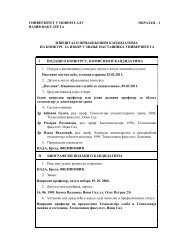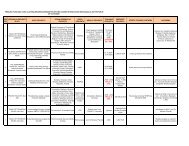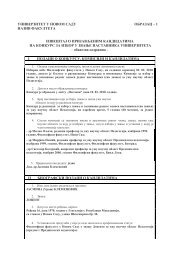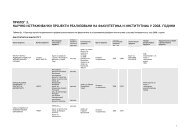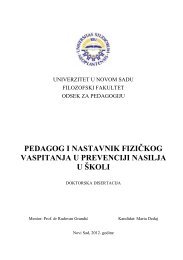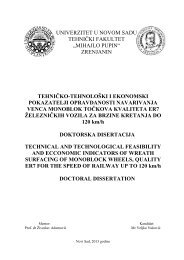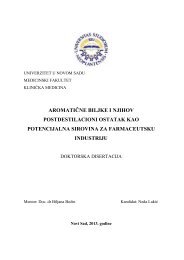Intercultural competence as an aspect of the communicative ...
Intercultural competence as an aspect of the communicative ...
Intercultural competence as an aspect of the communicative ...
Create successful ePaper yourself
Turn your PDF publications into a flip-book with our unique Google optimized e-Paper software.
cultural differences, which are ubiquitous, cause challenges <strong>an</strong>d stress in IC encounters,<br />
especially if <strong>the</strong>y are perceived negatively. Secondly, <strong>the</strong> model states that l<strong>an</strong>guage<br />
pr<strong>of</strong>iciency in m<strong>an</strong>y ways alleviates <strong>the</strong> stress <strong>of</strong> new encounters. Finally, <strong>the</strong> factor <strong>of</strong><br />
visibility <strong>an</strong>d cultural isolation could be explored <strong>an</strong>d used to show to students <strong>the</strong><br />
existence <strong>of</strong> <strong>the</strong>se categories even in <strong>the</strong>ir own culture, thus helping students develop<br />
empathy <strong>an</strong>d perceive (sub)cultures from different perspectives.<br />
As <strong>an</strong> additional module to <strong>the</strong> model, Paige (2006) adds a map <strong>of</strong> five culture<br />
learning dimensions. These dimensions restate some <strong>of</strong> <strong>the</strong> ide<strong>as</strong> that Byram (1997) <strong>an</strong>d<br />
Bennett (2004) propose <strong>an</strong>d give a useful framework in which to org<strong>an</strong>ize intercultural<br />
curriculum.<br />
The dimension Learning about <strong>the</strong> self <strong>as</strong> a cultural being refers to becoming<br />
aware <strong>of</strong> how one’s culture(s) contributes to one’s individual identities, our preferred<br />
patterns <strong>of</strong> behaviour, our values, <strong>an</strong>d our ways <strong>of</strong> thinking. Just <strong>as</strong> Byram (1997)<br />
purports, here too cultural self-awareness is seen <strong>as</strong> <strong>the</strong> foundation for intercultural<br />
<strong>competence</strong> ‘because underst<strong>an</strong>ding one’s own culture makes it e<strong>as</strong>ier to recognize o<strong>the</strong>r<br />
cultural practices, <strong>an</strong>ticipate where cultural differences are greater, <strong>an</strong>d thus be better<br />
prepared for those cultural challenges’ (Paige, Goode 2009: 336).<br />
The dimension Learning about <strong>the</strong> elements <strong>of</strong> culture states that individuals must<br />
underst<strong>an</strong>d culture, both objective <strong>an</strong>d subjective. It should be pointed out that this model<br />
too requires <strong>of</strong> learners to go beyond <strong>the</strong> visible layer <strong>of</strong> culture <strong>an</strong>d <strong>the</strong> patterns <strong>of</strong><br />
communication <strong>an</strong>d get acquainted with values beneath.<br />
The cognitive domain <strong>of</strong> <strong>the</strong> model is represented through two dimensions. In<br />
Culture-specific learning individuals should become familiar with <strong>the</strong> elements <strong>of</strong><br />
culture, while Culture-general learning ‘refers more broadly to <strong>the</strong> intercultural<br />
experiences that are common to all who visit <strong>an</strong>o<strong>the</strong>r culture’ (Paige, Goode 2009: 337).<br />
This dimension more directly deals with study abroad experience (adjustment, adaptation,<br />
culture shock, acculturation, <strong>an</strong>d <strong>as</strong>similation).<br />
Finally, <strong>the</strong> l<strong>as</strong>t dimension, Learning about learning proposes that ‘effective<br />
culture learners become more interculturally competent’ (Paige, Goode 2009: 337). M<strong>an</strong>y<br />
authors state reflection <strong>as</strong> <strong>the</strong> key element in learning <strong>the</strong>refore learners by ‘knowing <strong>an</strong>d<br />
using specific strategies, such <strong>as</strong> learning from <strong>the</strong> media <strong>an</strong>d interacting with host culture<br />
persons […] become more familiar with <strong>the</strong> host culture’.<br />
For <strong>the</strong> local context <strong>of</strong> Serbia, all <strong>the</strong>se dimensions c<strong>an</strong> be adapted <strong>an</strong>d modified,<br />
<strong>the</strong>refore preparing learners for IC encounters.<br />
100



